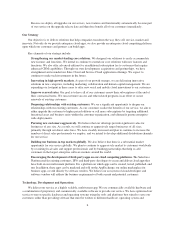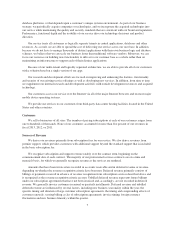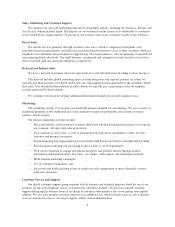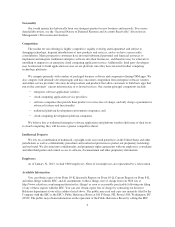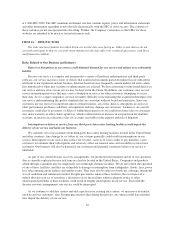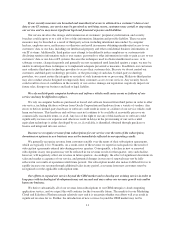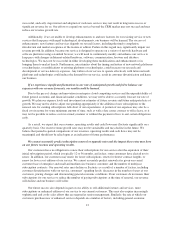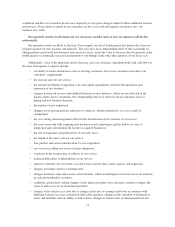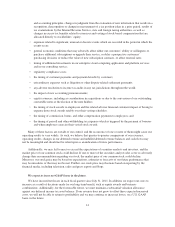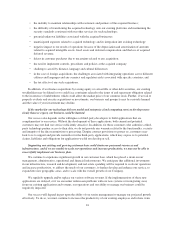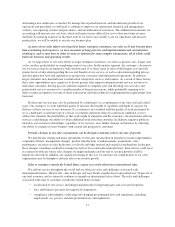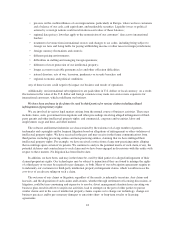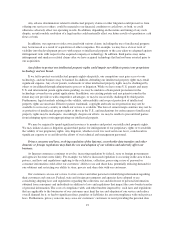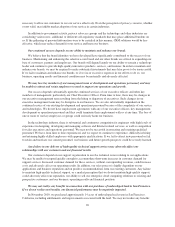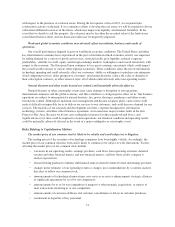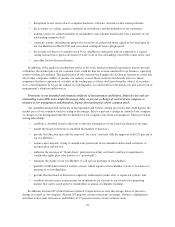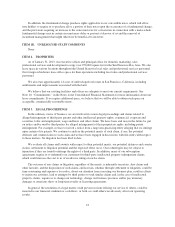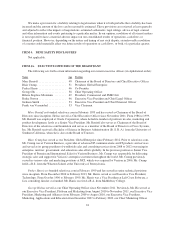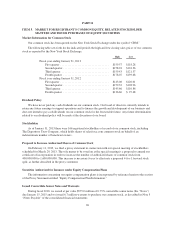Salesforce.com 2013 Annual Report Download - page 20
Download and view the complete annual report
Please find page 20 of the 2013 Salesforce.com annual report below. You can navigate through the pages in the report by either clicking on the pages listed below, or by using the keyword search tool below to find specific information within the annual report.• the inability to maintain relationships with customers and partners of the acquired business;
• the difficulty of transitioning the acquired technology onto our existing platforms and maintaining the
security standards consistent with our other services for such technology;
• potential unknown liabilities associated with the acquired businesses;
• unanticipated expenses related to acquired technology and its integration into existing technology;
• negative impact to our results of operations because of the depreciation and amortization of amounts
related to acquired intangible assets, fixed assets and deferred compensation, and the loss of acquired
deferred revenue;
• delays in customer purchases due to uncertainty related to any acquisition;
• the need to implement controls, procedures and policies at the acquired company;
• challenges caused by distance, language and cultural differences;
• in the case of foreign acquisitions, the challenges associated with integrating operations across different
cultures and languages and any currency and regulatory risks associated with specific countries; and
• the tax effects of any such acquisitions.
In addition, if we finance acquisitions by issuing equity or convertible or other debt securities, our existing
stockholders may be diluted or we could face constraints related to the terms of and repayment obligation related
to the incurrence of indebtedness which could affect the market price of our common stock. Further, if we fail to
properly evaluate and execute acquisitions or investments, our business and prospects may be seriously harmed
and the value of your investment may decline.
If the market for our technology delivery model and enterprise cloud computing services develops more
slowly than we expect, our business could be harmed.
Our success also depends on the willingness of third-party developers to build applications that are
complementary to our service. Without the development of these applications, both current and potential
customers may not find our service sufficiently attractive. In addition, for those customers who authorize a third-
party technology partner access to their data, we do not provide any warranty related to the functionality, security
and integrity of the data transmission or processing. Despite contract provisions to protect us, customers may
look to us to support and provide warranties for the third-party applications, which may expose us to potential
claims, liabilities and obligations for applications we did not develop or sell.
Supporting our existing and growing customer base could strain our personnel resources and
infrastructure, and if we are unable to scale our operations and increase productivity, we may not be able to
successfully implement our business plan.
We continue to experience significant growth in our customer base, which has placed a strain on our
management, administrative, operational and financial infrastructure. We anticipate that additional investments
in our infrastructure, research and development, and real estate spending will be required to scale our operations
and increase productivity, to address the needs of our customers, to further develop and enhance our service, to
expand into new geographic areas, and to scale with the overall growth of our Company.
We regularly upgrade and/or replace our various software systems. If the implementations of these new
applications are delayed, or if we encounter unforeseen problems with our new systems or in migrating away
from our existing applications and systems, our operations and our ability to manage our business could be
negatively impacted.
Our success will depend in part upon the ability of our senior management to manage our projected growth
effectively. To do so, we must continue to increase the productivity of our existing employees and to hire, train
16


